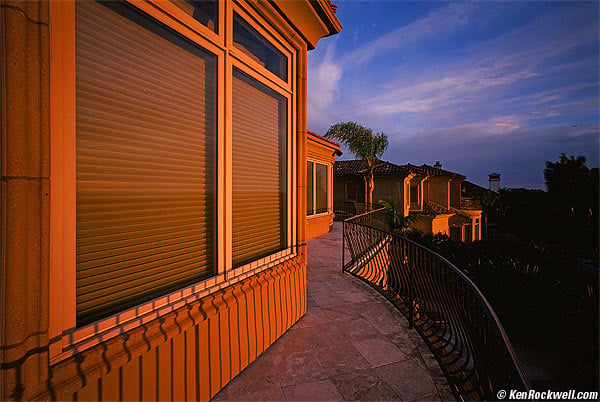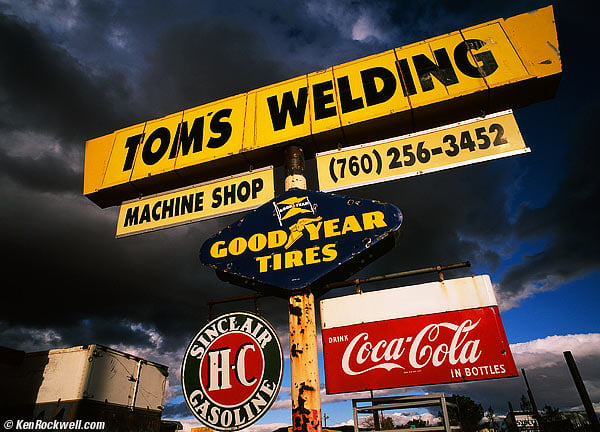Home New Search Gallery How-To Books Links Workshops About Contact
Lighting
© 2009 KenRockwell.com. All rights reserved.
It helps me keep adding to this site when you use these links to Adorama, Amazon, B&H, Calumet, Ritz, J&R and eBay to get your goodies. Thanks! Ken.
April 2009 How to make great pictures
NEW: Perfect Highlights and Shadows 17 January 2010.
Better Pictures: The Secret Composition Simplicity FART Shadows Lighting
Adjustments It's Not Your Camera Exposure WB Don't Worry: Shoot
Lighting is the most important technical aspect of any photograph. Cameras, lenses, and everything else are completely irrelevant unless you have good enough light to make a good photo.
No amount of Photoshop or plug-in software filters can replicate good light.
No amount of Hollywood special effects can change the lighting if it wasn't there to begin with, unless you repaint each and every pixel the hard way.
How do we get great light in Hollywood? We make it with three trucks of generators and lighting equipment. That's all the junk you see on a movie set: it's all the lights, scrims, gobos and supports for it all. Half the names you read in the credits are the guys who have to rig all this up. All that lighting is there to make everything look natural, as if there was no artificial lighting used at all. The camera itself is tiny by comparison.
When you shoot in a studio, or shoot smaller subjects like people outdoors, you can bring your own lighting. When it comes to photographing mountains, you're probably going to have to take whatever light you're dealt by God and nature. Most of my discussion refers to natural light; in a studio, its far more complex. In all cases, you follow your eye to highlight what you want, and downplay what you don't.
This article mostly deals with natural lighting. For studio lighting, see Studio Lighting.
When you work in nature and don't have a $10,000,000 budget to create your own lighting outdoors, you have to wait for nature to do its thing.
No matter how expensive your camera, lighting is everything, so if you don't have spectacular light, you won't get spectacular images.
Here's an example. Roll your mouse over the image to see this same shot made a few hours later in better light.
Aviara Drive. (roll mouse over to see in better light.) Bad photo made with Leica Super-Angulon 21mm f/4 lens, f/9.5 at 1/30 with careful manual exposure, 39mm 81A warming filter, RVP50, NCPS scan.
In case you're on an iPod or iPhone and have no mouse, here's the shot made in better lighting:

Aviara Drive. Voigtländer 15mm lens, no filter, f/8 at 1/15, hand-held Leica M7, RVP50, NCPS scan. enlarge.
What changed is that the gray shot was made in the morning while the building was in shadow, and the better shot was shot as the sun set and threw gobs of gorgeous orange light over everything.
The sky stays blue, adding a huge orange/blue contrast between foreground and background, making the building pop off the page.
Perception top
The difference above is like night and day, but what's critical to realize is that when I was there and making each of these shots, that I didn't feel that the light was that different each time!
It is only through the experience of making photos in many kinds of light and seeing what I get that I developed the ability to identify light that results in eye-catching images.
Our eyes and brains do magnificent work of letting us see things as they are, while eliminating the huge variations in lighting. This is great for our own perception, but since cameras see what's there and not what we're seeing, horrible for helping us see what will look good in a photo without a little experience.
Even in crappy light, our eyes see great images, which won't turn out that way in photos. This helps us see in any condition. It also prevents most people from being able to recognize great light, since our eyes don't see it directly.
You have to learn from a little experience what makes great light for the kinds of photos you like to take.
For instance, the crummy shot looked OK when I was there. It didn't look at all blue. Our eyes let us see detail in what looks like a dark building in shadow as well as in the bright sky in the upper right. Only as a photo does the contrast pick up to put the slightly darker building in dark black shadows, and does it all turn blue because it's lit by blue sky, not the sun.
The first shot is made the way most people make shots: they make a snap as they come up to something without any consideration of the lighting, and even if they worry themselves sick with WB settings and equipment, the shot will probably still suck.
Light is everything in photography. Equipment is nothing.
In this case, I shot the crappy gray shot with a genuine Made-in-Germany Leica 21mm f/4 lens and a warming filter, and I made the far better shot with a cheap Japanese Voigtländer 15mm lens and no filters at all. The cheaper lens made a much better image. Why? The light!
What is Great Light? top
It's different for every subject.
For the nature and landscape stuff I love, the best light is the first and last few seconds of orange sunlight as the sun is rising or setting.
This is good, and it gets fantastic when you can get these golden rays lighting a subject against a dark sky in the background.
Clearing storms are the best. Here in California, the weather comes from the west, so at sunset after a storm, the sun peeks out under the clouds to illuminate the subject, while the dark clouds retreating to the east serve as a background.
Tom's Welding in good light, February 2009. enlarge. Leica M7, 21mm f/2.8 ASPH and 81A, Fuji Velvia 50, NCPS develop and scan. Tech Details.
The lighting makes this shot.
At any other time in rain-free Southern California, this shot wouldn't have been that interesting — it would have just been a sign.
Hit the yellow sign with yellow light against a dark blue sky, and you have a lot of factors working to bring the sign forward in the image:
1.) We know it's in front of the clouds. This is a minor point; shoot this in the morning when the sign is in backlight, or on an overcast day, and it's a flat image.
In backlight, which is the first half of the day for this sign, the sky behind the sign will be lighter than the sign, and in any photo our eyes will be drawn into the sky and away from the silhouette of the sign!
2.) Reds and yellows come forward, while blues recede. This is the way our eyes respond to color; just ask any painter. Since the sign already is yellow, it will come forward.
3.) The yellow light shining on the sign makes it even yellower, making it stand out even more.
4.) The blue storm clouds aren't being hit by the same light; they are in shadow from another cloud. As I'm shooting this, the sign kept popping in and out of the light as the clouds moved. Most of the time, the sun was behind the cloud and the light was awful. It only got like this for a few seconds at a time.
5.) Shooting with Fuji Velvia 50, this film makes warm colors warmer while leaving cool colors alone, further exaggerating the effect.
Weather top
Most people would have stayed home the weekend I shot this.
Most of the time, it was overcast.
The payoff is that the few times the sun popped out, we got amazing light beyond anything I usually see.
In photography, only show your best shots. The best shots are all that matter.
The crummy weather gave us mostly bad light, with a few minutes of spectacular light.
Since we only show the best shots, the shots we show from this trip are spectacular.
If we had perfect (for hiking) sunny days, the light would have been OK for many hours, but never have had the fantastic dark backgrounds that makes this shot pop.
Seek out breaking and clearing storms. One of Ansel's most famous works is titled "Clearing Winter Storm."
Summary top
Pay rapt attention the light. Seek it out.
Make your travel plans around the light. Do everything you can to learn what light looks good to you in your photos, and shoot in it.
Not only is light far more important than your camera, lighting is far more important than your choice of subject, at least for nature and outdoor photography.
I'm known as a toilet photographer, but it's not the toilets; it's the fact that I shoot them in good light.
Shoot the most scenic thing on the planet, say the Grand Canyon, in dull light, and it's a dull photograph.
Shoot the dullest thing on the planet, like a toilet, in great light, and it looks great.
People tell me I can make even a junk yard look so nice that they'd like to live there. I do this by shooting it in the nicest light.
People have been living in caves for hundreds of thousands of years. This is what defines our powerful subconscious perceptions.
When we see a warm fire in our cave, we feel good. Fire on, good. Fire out, bad.
Putting bright, warm colors in the foreground, and emphasize it with cold blue outside in back, makes us feel good. It's as simple and powerful as that.
PLUG top
I support my growing family through this website.
If you find this as helpful as a book you might have had to buy or a workshop you may have had to take, feel free to help me continue helping everyone.
If you've gotten your gear through one of my links or helped otherwise, you're family. It's great people like you who allow me to keep adding to this site full-time. Thanks!
If you haven't helped yet, please do, and consider helping me with a gift of $5.00.
The biggest help is when you use any of these links when you get anything. It costs you nothing, and is this site's, and thus my family's, biggest source of support. These places always have the best prices and service, which is why I've used them since before this website existed. I recommend them all personally.
Thanks for reading!
Ken
Home New Search Gallery How-To Books Links Workshops About Contact


